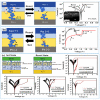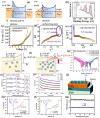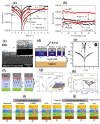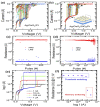Recent Advances in Cerium Oxide-Based Memristors for Neuromorphic Computing
- PMID: 37686950
- PMCID: PMC10489950
- DOI: 10.3390/nano13172443
Recent Advances in Cerium Oxide-Based Memristors for Neuromorphic Computing
Abstract
This review article attempts to provide a comprehensive review of the recent progress in cerium oxide (CeO2)-based resistive random-access memories (RRAMs). CeO2 is considered the most promising candidate because of its multiple oxidation states (Ce3+ and Ce4+), remarkable resistive-switching (RS) uniformity in DC mode, gradual resistance transition, cycling endurance, long data-retention period, and utilization of the RS mechanism as a dielectric layer, thereby exhibiting potential for neuromorphic computing. In this context, a detailed study of the filamentary mechanisms and their types is required. Accordingly, extensive studies on unipolar, bipolar, and threshold memristive behaviors are reviewed in this work. Furthermore, electrode-based (both symmetric and asymmetric) engineering is focused for the memristor's structures such as single-layer, bilayer (as an oxygen barrier layer), and doped switching-layer-based memristors have been proved to be unique CeO2-based synaptic devices. Hence, neuromorphic applications comprising spike-based learning processes, potentiation and depression characteristics, potentiation motion and synaptic weight decay process, short-term plasticity, and long-term plasticity are intensively studied. More recently, because learning based on Pavlov's dog experiment has been adopted as an advanced synoptic study, it is one of the primary topics of this review. Finally, CeO2-based memristors are considered promising compared to previously reported memristors for advanced synaptic study in the future, particularly by utilizing high-dielectric-constant oxide memristors.
Keywords: CeO2; RRAM memristive devices; capping layers; filamentary mechanisms; neuromorphic learning systems; switching layers; symmetric and asymmetric electrodes; synaptic devices.
Conflict of interest statement
The authors declare that they have no known competing financial interest or personal relationships that could have appeared to influence the work reported in this paper.
Figures




















References
-
- Hermes C., Wimmer M., Menzel S., Fleck K., Bruns G., Salinga M., Bottger U., Bruchhaus R., Schmitz-Kempen T., Wuttig M., et al. Analysis of Transient Currents During Ultrafast Switching of TiO2 Nanocrossbar Devices. IEEE Electron Device Lett. 2011;32:1116–1118. doi: 10.1109/LED.2011.2156377. - DOI
-
- Snider G.S. Spike-timing-dependent learning in memristive nanodevices; Proceedings of the 2008 IEEE International Symposium on Nanoscale Architectures; Anaheim, CA, USA. 12–13 June 2008; pp. 85–92.
Publication types
LinkOut - more resources
Full Text Sources

